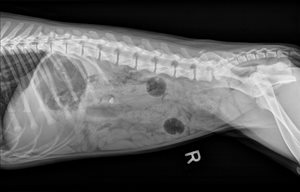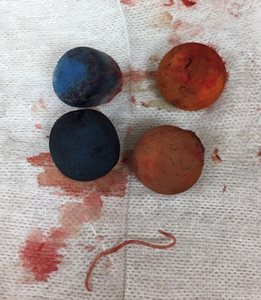The other week, our team examined and treated a lovely 4.5-month-old female golden retriever named Molly. Molly presented with acute vomiting and not feeling like herself. The morning of Molly’s appointment, her owners noted she vomited up two foam Nerf balls and continued to vomit into the early afternoon, this prompted the visit to our clinic. The owners recalled Molly experiencing gagging episodes in the evenings for the past 2-3 weeks. During these episodes, she did not vomit and was otherwise doing well. Before this visit, Molly was an overall healthy dog. However, recent exams indicated Molly had a sensitive stomach and required being on a special gastrointestinal diet.
During our exam, we noticed that Molly had two retained deciduous teeth. Deciduous teeth are retained when adult teeth do not push out the puppy teeth. The result is crowding in the mouth and subsequent increased risk of dental disease. While in the exam room, Molly continued to gag and vomited a small amount of bile. Her abdomen was mildly painful when palpated, and we were able to feel an unusual firm presence within the intestines. We suspected that more Nerf balls might be present and recommended taking radiographs to see what was happening internally.

If you can see four Nerf balls in the radiograph (on top of this post), you would have agreed with our team. We suspected there was two Nerf balls in the stomach and another two in the intestines. Taking into account the frequent gagging for the past couple weeks, combined with the current acute vomiting, we determined the Nerf balls were not moving through the GI tract on their own. We suggested surgical intervention and the family agreed. Given Molly’s age and that she would already be under anesthesia, we recommended spaying her and removing the two lingering puppy teeth. This was a big day for Molly and her family.
We kept Molly in the hospital overnight, setting her up on fluid therapy and medications. This kept her hydrated and reduced the inflammation in the GI tract to help stop the vomiting, pain medications also were initiated. In the morning before surgery, we collected blood to assess her internal health. Her red blood cells were mildly low, and the Nerf balls were causing a bout of pancreatitis. We concluded the Nerf balls had likely been in the GI tract for the past two weeks and were causing chronic problems for Molly. The sooner we removed them, the better Molly would feel.
After a night of fluids and medications, Molly was feeling brighter and had ceased vomiting. She was well hydrated, pain-free and ready for her surgery. We repeated a radiograph, making sure the Nerf balls had not moved and that we were going looking in the right places. They hadn’t moved. Right before surgery, Molly experienced some gastric reflux. This is where fluid from the stomach moves backwards and starts coming out of the nose. Although this is not what we would like to see in any surgical patient, our team was prepared. As Molly was already intubated, there was little chance of the gastric fluid reaching the lungs and potentially causing an aspiration pneumonia. Our dedicated surgical technicians positioned Molly to drain the fluid and monitored her tightly until the problem resolved. Without our highly trained technicians monitoring this surgery, the outcome might have been different. Proper intubation with fluid therapy, supportive care and pain control are essential components of any surgery under general anesthesia.
The surgical team started her procedure with her spay, both ovaries and the uterine body were removed. Then the interesting stuff began! We made an incision into the stomach (gastrostomy) and removed two nerf balls. We repaired the stomach and then went hunting through the intestines for the other two Nerf balls. Unfortunately for Molly, the Nerf balls were located in different areas of the intestine requiring two separate incisions (enterotomies). In the second enterotomy, we found a surprise – a live roundworm! You never know what you are going to find inside those intestines. Roundworms are common in puppies and easily treated.

After suturing all the surgical sites, we checked for leaks by injecting sterile saline into the incision area and pressure testing the sutures. It all looked great! We flushed the abdomen and closed Molly up. During surgery, our technical team kept Molly warm and hydrated. They monitored her blood pressure, temperature, heart rate, ECG, breathing patterns and anesthetic depth. Molly did great for the entire procedure. We continued with pain medications while lastly, the two deciduous teeth were removed. Finally, we woke Molly up. Her big surgery was over, and now our goal was providing a pain-free healing process.
Molly was able to go home to her family later that evening. She was sent home with more pain medications (you can see a theme), medications to protect her stomach and reduce gastric acid reflux, antibiotics and a medical pet shirt to prevent licking at her incision. A call to the family a few days later confirmed that she was still doing well. She was dewormed to get rid of those pesky roundworms, will stay on a gastrointestinal diet and will repeat blood work to ensure her pancreas has recovered in the new year. Overall, Molly did very well. This was a big day for Molly and her family. It is essential to monitor your furry friends, especially around kid’s toys. Christmas is a fantastic time of year but with all the excitement and new toys around it can be hard to keep track of everything. Especially four little nerf balls.
Written by Dr. Jeremy Mount, DVM